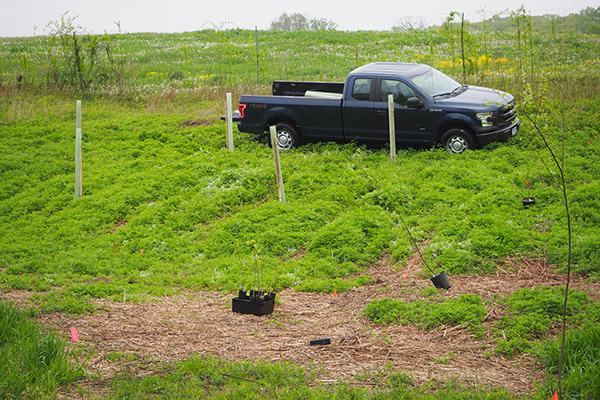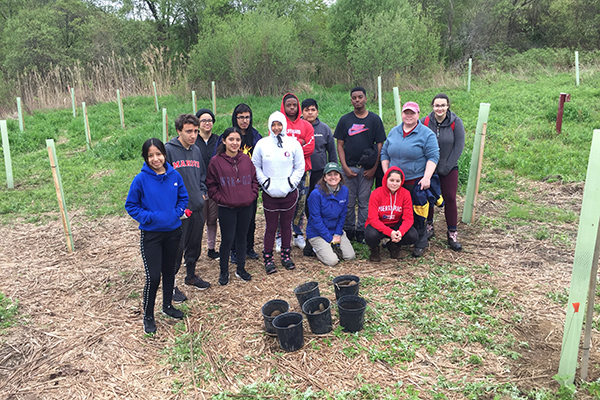Students from Ossining High School planted trees to protect water quality at Hilltop Hanover Farm in Yorktown Heights, NY.

Stream buffers, or the strips of vegetated land next to stream channels, are often described as the last line of defence between the stream and land management activities occurring further upslope. Buffers provide many functions, including sediment trapping, stream bank stabilization, nutrient uptake, stream temperature control, aquatic habitat, and more. For the last five years or so, Hilltop Hanover Farm has been steadily augmenting their stream buffer area with the help of the Croton Trees for Tribs program.
A look inside the intermittent stream buffer at Hilltop Hanover Farm.
On May 10, 2019, I joined WAC Watershed Educator Tyler Van Fleet, Ossining High School teacher Danielle Jackson, and her students to continue building the buffer at Hilltop Hanover Farm. The learning objectives for the day included proper tree planting techniques and understanding the relationship between forests and water quality.
Each of the tree species we would plant represented a unique combination in terms of their soil moisture requirements and the height they will reach at maturity. For example, red bud will grow to a height of 20-30 feet and likes drier conditions, whereas sycamore will grow to a height of 75-100 feet and likes wetter conditions. We used this information to choose where to plant each tree.

We planted sycamore, river birch, swamp white oak, black cherry, black oak, red bud, basswood, and silver maple at the Hilltop Hanover Farm streamside planting.
The planting area was a U-shaped swale located between a crop field and a stream. We would plant shorter trees along the edge of the crop field to avoid shading it out. Trees that could handle higher soil moisture conditions would be planted in the swale bottom and adjacent to the stream.
The streamside tree planting area at Hilltop Hanover Farm.
To begin, Tyler demonstrated tree planting techniques that would help to ensure tree survival. For example, the hole you dig should be about 1.5 times the pot diameter and roughly equal to the depth of the pot.

That looks about right!
With the hole dug, the next step is to remove the tree from its pot. Typically all that’s required here is to knead the pot a bit so that the tree roots and potting soil gently slide out of the container.
It’s natural for the tree roots to get bound up due to growing in a confined space. As such, you want to use your fingers to break up the bound roots. Tyler likened this method to shampooing your scalp. In a few instances, we had trees with formidable root systems that were looking to bust out of their containers.

At times, students had to use pruners to cut and loosen the bound tree roots.
As you probably can guess, the next steps involved placing the tree in the hole, backfilling with loose soil, and finishing with a light foot tamp. The key points here are to backfill in layers, using your fingers to knead the soil into the space around the roots/potting soil. When finished, the soil surface should cover all roots but leave the root collar exposed (to prevent fungal growth).
After Tyler and Danielle each planted a tree, we turned the students loose to plant some of their own. In total, the students planted 23 trees and secured them with tree tubes and wooden stakes. The tree tubes act as a barrier to deer browsing and the stakes allow the trees to develop strength by shaking in the wind (seriously!).

Ossining High School students digging holes in preparation for tree planting.
The students did a fine job with the tree planting and tree tube installation. It was great to interact with this group and bond over some manual labor in the name of water quality protection. Well done team!
Feeling accomplished!








